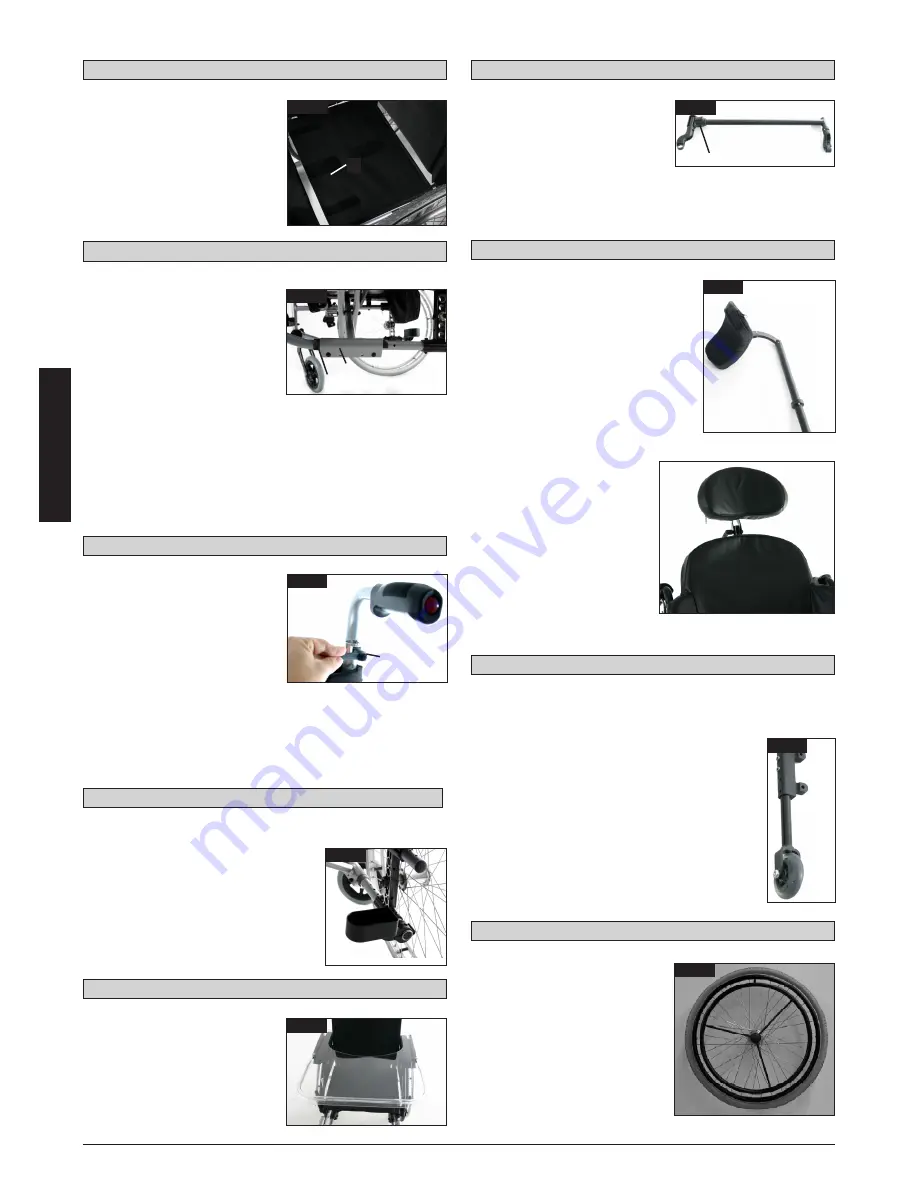
ENGLISH
13
BasiX, RubiX, RubiX XL Rev. 2
0806/1/ST-000690646.EMS
Options – Crutch holder
Crutch Holder
This device permits crutches to be
transported directly on a wheelchair. It has
a Velcro loop to fasten crutches or other
aids (Fig. 43).
CAUTION:
Never try to use or even remove the
crutches or other aids while moving.
Options - Therapy table
Therapy table
The tray provides a flat surface for
most activities. Before using a tray,
it first has to be adjusted to the
width of the seat by an authorised
dealer. The user must be sitting in
the wheelchair during this
adjustment (Fig. 44).
Options – Stabilising bar
Folding stabilising bar
This bar is used to stabilise the
backrest. To be able to fold the
wheelchair, the release lever (1)
must be pushed inwards and the
stabilising bar must be flipped downwards.
When unfolding the wheelchair, please make sure that the
stabilising bar is locked into position (Fig. 45).
Transit wheels
Transit wheels
should be used wherever your wheelchair would be
too wide if the rear wheels were used (e.g., in
airplanes, buses, etc.). After the rear wheels have
been removed with the aid of the quick-release axles,
the
transit wheels
can immediately be used to
continue riding. The
transit wheels
are mounted so
that they are approx. 3 centimeters above the ground
when not in use. They are thus out of the way when
riding, transporting or when tipping to pass over
obstacles (e.g., kerbs, steps, etc.) (Fig. 47).
CAUTION:
Your wheelchair does not have any wheel locks
when the transit wheels are being used.
Options – Transit wheels
Options – One-hand operation
One-hand operation
To move the wheelchair in a
straight line, both hand wheels must
be operated. If the wheelchair is to
be folded up, remove the pull-off
bar by pushing it inwards (Fig. 48).
CAUTION:
To avoid injury, always make
sure that all connections are
firmly in place.
Options – Headrests
Headrests
The headrest can be raised and moved
both forwards and backwards. To do this,
simply loosen the screw, adjust the
headrest to the desired position, and
tighten the screw (see the section on
torque) (Fig. 46).
Comfort headrest
For adjusting the height open
knob and position the headrest in
the desired height. Finally tighten
the knob again.
Options – Push handles
Height-adjustable push handles
These handles are secured with
pins to prevent them from sliding
out unintentionally. By releasing the
release lever (1) you can adjust the
push handles to a height which
suits you. After any adjustment to
the height of the push handles, pull
the release lever (1) until it is tight
(Fig. 42).
CAUTION:
If the lever is not secure, injuries could result when lifting over
obstacles.
Options – Seat depth
Seat depth
By removing the clips (1), the cross-
brace unit (2) can be pushed along
the frame, which then alters the
seat depth (depending on the
position of the back tubes).
Make sure that the clips (1) snap
into the frame holes provided.
To keep the frame as compact as possible, the seat depth can also
be adjusted by using the back tubes (41 – 46 cm in steps of 2.5 cm).
To do this remove the screws (1 and 2) on the back tube bracket.
Remove the wheels and the armrests and check that the cross-
brace is in the desired position (push the cross-brace as described
above). Move the back tubes to the desired position and re-tighten
all screws. Move the receiver tube for the armrests to the desired
position (Fig. 41).
1
2
1
1
Fig. 41
Fig. 42
Fig. 43
Fig. 44
Fig. 45
Fig. 46
Fig. 47
Fig. 48
Options – Seat depth growth
Seat depth growth
You can easily alter the seat depth
by using the Velcro fastener on the
seat sling.
Separate sling (1) from sling, set the
desiredposition and then
push both slings back together, one
on top of each other (Fig. 40).
1
Fig. 40





































